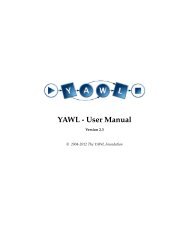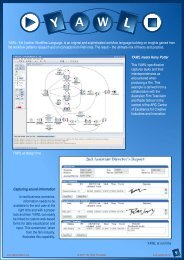Semantics, Verification, and Implementation of Workflows ... - YAWL
Semantics, Verification, and Implementation of Workflows ... - YAWL
Semantics, Verification, and Implementation of Workflows ... - YAWL
Create successful ePaper yourself
Turn your PDF publications into a flip-book with our unique Google optimized e-Paper software.
Chapter 2. Formal foundations<br />
Definition 2.18 (Backward firing) Let (P, T, F, R) be a reset net <strong>and</strong> M, M ′ ∈<br />
IM(N). M ′ t M iff it is possible to fire a transition t backwards starting from<br />
M <strong>and</strong> resulting in M ′ .<br />
M ′ t M ⇔ M[R(t)] ≤<br />
{<br />
t • [R(t)]∧<br />
(M(p)<br />
M ′ <br />
F (t, p)) + F (p, t) if p ∈ P \ R(t)<br />
(p) =<br />
F (p, t) if p ∈ R(t).<br />
For places that are not reset places, the number <strong>of</strong> tokens in M ′ is determined<br />
by the number <strong>of</strong> tokens in M for p <strong>and</strong> the production <strong>and</strong> consumption <strong>of</strong><br />
tokens. If a place is an output place <strong>of</strong> t <strong>and</strong> not a reset place, one token is<br />
removed from M(p) if M(p) > 0. If a place is an input place <strong>of</strong> t <strong>and</strong> not a<br />
reset place, one token is added to M(p). For any reset place p, M(p) ≤ F (t, p)<br />
because it is emptied when firing <strong>and</strong> then F (t, p) tokens are added. We do not<br />
require M(p) = F (t, p) for a reset place p because the aim is coverability <strong>and</strong><br />
not reachability. M ′ , i.e., the marking before (forward) firing t, should at least<br />
contain the minimal number <strong>of</strong> tokens required for enabling t <strong>and</strong> resulting in a<br />
marking <strong>of</strong> at least M. Therefore, only F (p, t) tokens are assumed to be present<br />
in a reset place p.<br />
2.2 WF-nets <strong>and</strong> RWF-nets<br />
This section discusses the formalisation <strong>of</strong> workflow models using Petri nets. The<br />
definition <strong>of</strong> a WorkFlow net (WF-net) serves as the basis for the formal definition<br />
<strong>of</strong> a <strong>YAWL</strong> net. The notion <strong>of</strong> a Reset WorkFlow net (RWF-net) is introduced<br />
to represent workflows with cancellation features.<br />
A WF-net is defined as a subclass <strong>of</strong> Petri net with the following structural<br />
restrictions [Aal98b]. There is exactly one begin place <strong>and</strong> exactly one end place.<br />
Moreover, every node in the graph is on a directed path from the begin place to<br />
the end place.<br />
Definition 2.19 (WF-net [Aal98b, Ver04]) Let N = (P, T, F ) be a Petri<br />
net. The net N is a WF-net iff the following three conditions hold:<br />
1. there exists exactly one i ∈ P such that •i = ∅, <strong>and</strong><br />
2. there exists exactly one o ∈ P such that o• = ∅, <strong>and</strong><br />
3. for all n ∈ P ∪ T : (i, n) ∈ F ∗ <strong>and</strong> (n, o) ∈ F ∗ .<br />
We define Reset WorkFlow nets (RWF-nets) which are reset nets with the<br />
same structural restrictions as WF-nets. RWF-nets represent a subclass <strong>of</strong> reset<br />
nets.<br />
Definition 2.20 (RWF-net) Let N = (P, T, F, R) be a reset net. The net N is<br />
an RWF-net iff (P, T, F ) is a WF-net.<br />
In an RWF-net, there is an input place i <strong>and</strong> an output place o <strong>and</strong> an initial<br />
marking M i <strong>and</strong> an end marking M o is defined as follows:<br />
PhD Thesis – c○ 2006 M.T.K Wynn – Page 17





